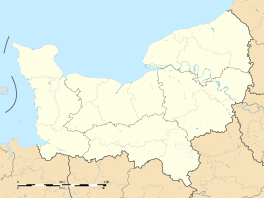Authie, Calvados
| Authie | |
|---|---|
| Commune | |

Authie Town Hall
|
|
| Coordinates: 49°12′24″N 0°25′50″W / 49.2067°N 0.4306°WCoordinates: 49°12′24″N 0°25′50″W / 49.2067°N 0.4306°W | |
| Country | France |
| Region | Normandy |
| Department | Calvados |
| Arrondissement | Caen |
| Canton | Caen-2 |
| Intercommunality | CU Caen Mer |
| Government | |
| • Mayor (2014-2020) | Joël Pizy |
| Area1 | 3.21 km2 (1.24 sq mi) |
| Population (2015)2 | 1,570 |
| • Density | 490/km2 (1,300/sq mi) |
| Time zone | CET (UTC+1) |
| • Summer (DST) | CEST (UTC+2) |
| INSEE/Postal code | 14030 /14280 |
| Elevation | 60–73 m (197–240 ft) (avg. 65 m or 213 ft) |
|
1 French Land Register data, which excludes lakes, ponds, glaciers > 1 km2 (0.386 sq mi or 247 acres) and river estuaries. 2Population without double counting: residents of multiple communes (e.g., students and military personnel) only counted once. |
|
1 French Land Register data, which excludes lakes, ponds, glaciers > 1 km2 (0.386 sq mi or 247 acres) and river estuaries.
Authie is a French commune in the Calvados department in the Normandy region of north-western France.
The inhabitants of the commune are known as Althavillais or Althavillaises.
The commune has been awarded one flower by the National Council of Towns and Villages in Bloom in the Competition of cities and villages in Bloom.
Authie is located some 6 km (4 mi) north-west of the centre of Caen. Access to the commune is by road D220 from Villons-les-Buissons in the north-east which passes through the centre of the commune and the village and continues to Carpiquet in the south. The D220C also goes south-east from the village to the urban area of Caen. There are also the hamlets of Hameau de Saint-Louet, Franqueville, Fermie du Calvaire, and Cussy in the commune. Apart from the large residential area the commune is entirely farmland.
The name of the town is attested in the forms Alteium in 1227 and Auteya in 1264.
Albert Dauzat matched Authie with Authie in Somme department (Altegiam 830) on the coastal river Authie (Alteia 723) and considers it primarily as a hydronym but does not provide any further explanation.
According to René Lepelley this toponym is based on the pre-Celtic element alt in an unknown sense and is close to Authou in Pont-Authou.
François de Beaurepaire sees a Gallic (Celtic) element in the alt in Authou.
The Gallic term Attegia was recognized by Xavier Delamarre in Atheist-type names - e.g. Athis in the sense of "cabin or hut".
This analyses to ad- (pre-verb) and tegia meaning "house" (cf. Old Irish teg, old Welsh tig, Welsh Ty, Old Breton tig, and Breton ti all meaning "house").
...
Wikipedia


